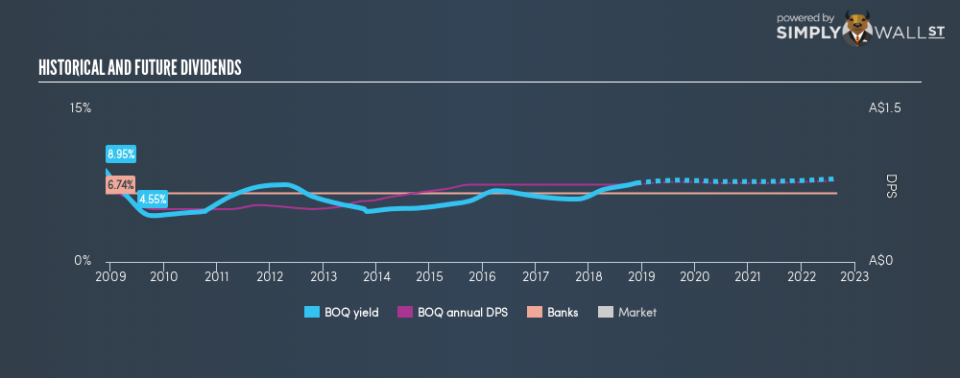What Makes Bank of Queensland Limited (ASX:BOQ) A Great Dividend Stock?

Over the past 10 years Bank of Queensland Limited (ASX:BOQ) has been paying dividends to shareholders. The company is currently worth AU$3.9b, and now yields roughly 7.8%. Does Bank of Queensland tick all the boxes of a great dividend stock? Below, I’ll take you through my analysis.
View our latest analysis for Bank of Queensland
5 questions to ask before buying a dividend stock
If you are a dividend investor, you should always assess these five key metrics:
Is it paying an annual yield above 75% of dividend payers?
Has its dividend been stable over the past (i.e. no missed payments or significant payout cuts)?
Has dividend per share risen in the past couple of years?
Does earnings amply cover its dividend payments?
Will the company be able to keep paying dividend based on the future earnings growth?
How well does Bank of Queensland fit our criteria?
The current trailing twelve-month payout ratio for the stock is 89%, meaning the dividend is sufficiently covered by earnings. Going forward, analysts expect BOQ’s payout to remain around the same level at 87% of its earnings, which leads to a dividend yield of 8.0%. Furthermore, EPS should increase to A$0.87.
When assessing the forecast sustainability of a dividend it is also worth considering the cash flow of the business. Cash flow is important because companies with strong cash flow can usually sustain higher payout ratios.
If there is one thing that you want to be reliable in your life, it’s dividend stocks and their constant income stream. Whilst its per-share payments have increased during the past 10 years, there has been some hiccups. Investors have seen reductions in the dividend per share in the past, although, it has picked up again.
In terms of its peers, Bank of Queensland produces a yield of 7.8%, which is high for Banks stocks.
Next Steps:
With these dividend metrics in mind, I definitely rank Bank of Queensland as a strong income stock, and is worth further research for anyone who considers dividends an important part of their portfolio strategy. Given that this is purely a dividend analysis, you should always research extensively before deciding whether or not a stock is an appropriate investment for you. I always recommend analysing the company’s fundamentals and underlying business before making an investment decision. I’ve put together three pertinent factors you should further examine:
Future Outlook: What are well-informed industry analysts predicting for BOQ’s future growth? Take a look at our free research report of analyst consensus for BOQ’s outlook.
Valuation: What is BOQ worth today? Even if the stock is a cash cow, it’s not worth an infinite price. The intrinsic value infographic in our free research report helps visualize whether BOQ is currently mispriced by the market.
Other Dividend Rockstars: Are there better dividend payers with stronger fundamentals out there? Check out our free list of these great stocks here.
To help readers see past the short term volatility of the financial market, we aim to bring you a long-term focused research analysis purely driven by fundamental data. Note that our analysis does not factor in the latest price-sensitive company announcements.
The author is an independent contributor and at the time of publication had no position in the stocks mentioned. For errors that warrant correction please contact the editor at editorial-team@simplywallst.com.

 Yahoo Finance
Yahoo Finance 
